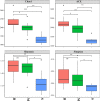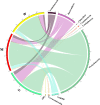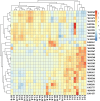Comparison of bacterial community structure and potential functions in hypoxic and non-hypoxic zones of the Changjiang Estuary
- PMID: 31170168
- PMCID: PMC6553723
- DOI: 10.1371/journal.pone.0217431
Comparison of bacterial community structure and potential functions in hypoxic and non-hypoxic zones of the Changjiang Estuary
Abstract
Bacterioplankton play a key role in the global cycling of elements. To characterize the effects of hypoxia on bacterioplankton, bacterial community structure and function were investigated in the Changjiang Estuary. Water samples were collected from three layers (surface, middle, and bottom) at ten sampling sites in the Changjiang Estuary hypoxic and non-hypoxic zones. The community structure was analyzed using high-throughput sequencing of 16S rDNA genes, and the predictive metagenomic approach was used to investigate the functions of the bacterial community. Co-occurrence networks are constructed to investigate the relationship between different bacterioplankton. The results showed that community composition in hypoxic and non-hypoxic zones were markedly different. The diversity and richness of bacterial communities in the bottom layer (hypoxic zone) were remarkably higher than that of the surface layer (non-hypoxic). In the non-hypoxic zone, it was found that Proteobacteria, Bacteroidetes, and Flavobacteriia were the dominant groups while Alphaproteobacteria, SAR406 and Deltaproteobacteria were the dominant groups in the hypoxic zone. From the RDA analysis, it was shown that dissolved oxygen (DO) explained most of the bacterial community variation in the redundancy analysis targeting only hypoxia zones, whereas nutrients and salinity explained most of the variation across all samples in the Changjiang Estuary. To understand the genes involved in nitrogen metabolism, an analysis of the oxidation state of nitrogen was performed. The results showed that the bacterial community in the surface layer (non-hypoxic) had more genes involved in dissimilatory nitrate reduction, assimilatory nitrate reduction, denitrification, and anammox, while that in the middle and bottom layers (hypoxic zone) had more abundant genes associated with nitrogen fixation and nitrification. Co-occurrence networks revealed that microbial assemblages in the middle and bottom layers shared more niche spaces than in the surface layer (non-hypoxic zone). The environmental heterogeneity in the hypoxic and non-hypoxic zones might be important environmental factors that determine the bacterial composition in these two zones.
Conflict of interest statement
The authors have declared that no competing interests exist.
Figures











Similar articles
-
Distinct Features of Sedimentary Archaeal Communities in Hypoxia and Non-Hypoxia Regions off the Changjiang River Estuary.Microbiol Spectr. 2022 Oct 26;10(5):e0194722. doi: 10.1128/spectrum.01947-22. Epub 2022 Sep 6. Microbiol Spectr. 2022. PMID: 36066619 Free PMC article.
-
Bacterial diversity in the surface sediments of the hypoxic zone near the Changjiang Estuary and in the East China Sea.Microbiologyopen. 2016 Apr;5(2):323-39. doi: 10.1002/mbo3.330. Epub 2016 Jan 27. Microbiologyopen. 2016. PMID: 26817579 Free PMC article.
-
Active degradation-nitrification microbial assemblages in the hypoxic zone in a subtropical estuary.Sci Total Environ. 2023 Dec 15;904:166694. doi: 10.1016/j.scitotenv.2023.166694. Epub 2023 Sep 1. Sci Total Environ. 2023. PMID: 37660824
-
Bacterial diversity of water and sediment in the Changjiang estuary and coastal area of the East China Sea.FEMS Microbiol Ecol. 2009 Nov;70(2):80-92. doi: 10.1111/j.1574-6941.2009.00772.x. Epub 2009 Aug 28. FEMS Microbiol Ecol. 2009. PMID: 19780829
-
Distinct distribution patterns of prokaryotes between sediment and water in the Yellow River estuary.Appl Microbiol Biotechnol. 2016 Nov;100(22):9683-9697. doi: 10.1007/s00253-016-7802-3. Epub 2016 Aug 24. Appl Microbiol Biotechnol. 2016. PMID: 27557722
Cited by
-
Distinct Assembly Processes Structure Planktonic Bacterial Communities Among Near- and Offshore Ecosystems in the Yangtze River Estuary.Microb Ecol. 2024 Feb 14;87(1):42. doi: 10.1007/s00248-024-02350-x. Microb Ecol. 2024. PMID: 38356037 Free PMC article.
-
Effects of Sugarcane and Soybean Intercropping on the Nitrogen-Fixing Bacterial Community in the Rhizosphere.Front Microbiol. 2021 Sep 30;12:713349. doi: 10.3389/fmicb.2021.713349. eCollection 2021. Front Microbiol. 2021. PMID: 34659143 Free PMC article.
-
Bacterial Dynamics and Their Influence on the Biogeochemical Cycles in a Subtropical Hypereutrophic Lake During the Rainy Season.Front Microbiol. 2022 Apr 5;13:832477. doi: 10.3389/fmicb.2022.832477. eCollection 2022. Front Microbiol. 2022. PMID: 35479621 Free PMC article.
-
Distinct Features of Sedimentary Archaeal Communities in Hypoxia and Non-Hypoxia Regions off the Changjiang River Estuary.Microbiol Spectr. 2022 Oct 26;10(5):e0194722. doi: 10.1128/spectrum.01947-22. Epub 2022 Sep 6. Microbiol Spectr. 2022. PMID: 36066619 Free PMC article.
-
Bacterial and Protistan Community Variation across the Changjiang Estuary to the Ocean with Multiple Environmental Gradients.Microorganisms. 2022 May 9;10(5):991. doi: 10.3390/microorganisms10050991. Microorganisms. 2022. PMID: 35630434 Free PMC article.
References
-
- Chen JY, Li DJ, Chen BL, Hu FX, Zhu HF, Liu CZ. The processes of dynamic sedimentation in the Changjiang Estuary. J Sea Res. 1999;41(1–2):129–40. 10.1016/s1385-1101(98)00047-1 - DOI
Publication types
MeSH terms
Substances
LinkOut - more resources
Full Text Sources

